Holistic Care Plan: Violet Patterson's Acute Myocardial Infarction
VerifiedAdded on 2023/04/06
|11
|2981
|406
Case Study
AI Summary
This case study provides a detailed analysis of Violet Patterson, a 77-year-old woman admitted for acute myocardial infarction with a history of hypertension and osteoarthritis. The study emphasizes the importance of nursing assessments, including ECG, cardiac CT/MRI, blood tests, and pain assessment using the pain measurement scale and Fall Risk Assessment Tool (FRAT). It outlines nursing diagnoses such as decreased cardiac output, hypertension, and pain/fall risks due to osteoarthritis, along with corresponding interventions and evaluation methods. The care plan includes monitoring heart rate, medication therapy (calcium channel blockers, ACE inhibitors), physiotherapy, and environmental modifications to prevent falls. The study also highlights the significance of patient education regarding lifestyle modifications, diet management, exercise, and medication adherence to improve overall health outcomes and quality of life. Desklib offers a wealth of similar resources, including past papers and solved assignments, to support students in their studies.

Running head: VIOLET PATTERSON CASE STUDY
VIOLET PATTERSON CASE STUDY
Name of the student:
Name of the university:
Author note:
VIOLET PATTERSON CASE STUDY
Name of the student:
Name of the university:
Author note:
Paraphrase This Document
Need a fresh take? Get an instant paraphrase of this document with our AI Paraphraser
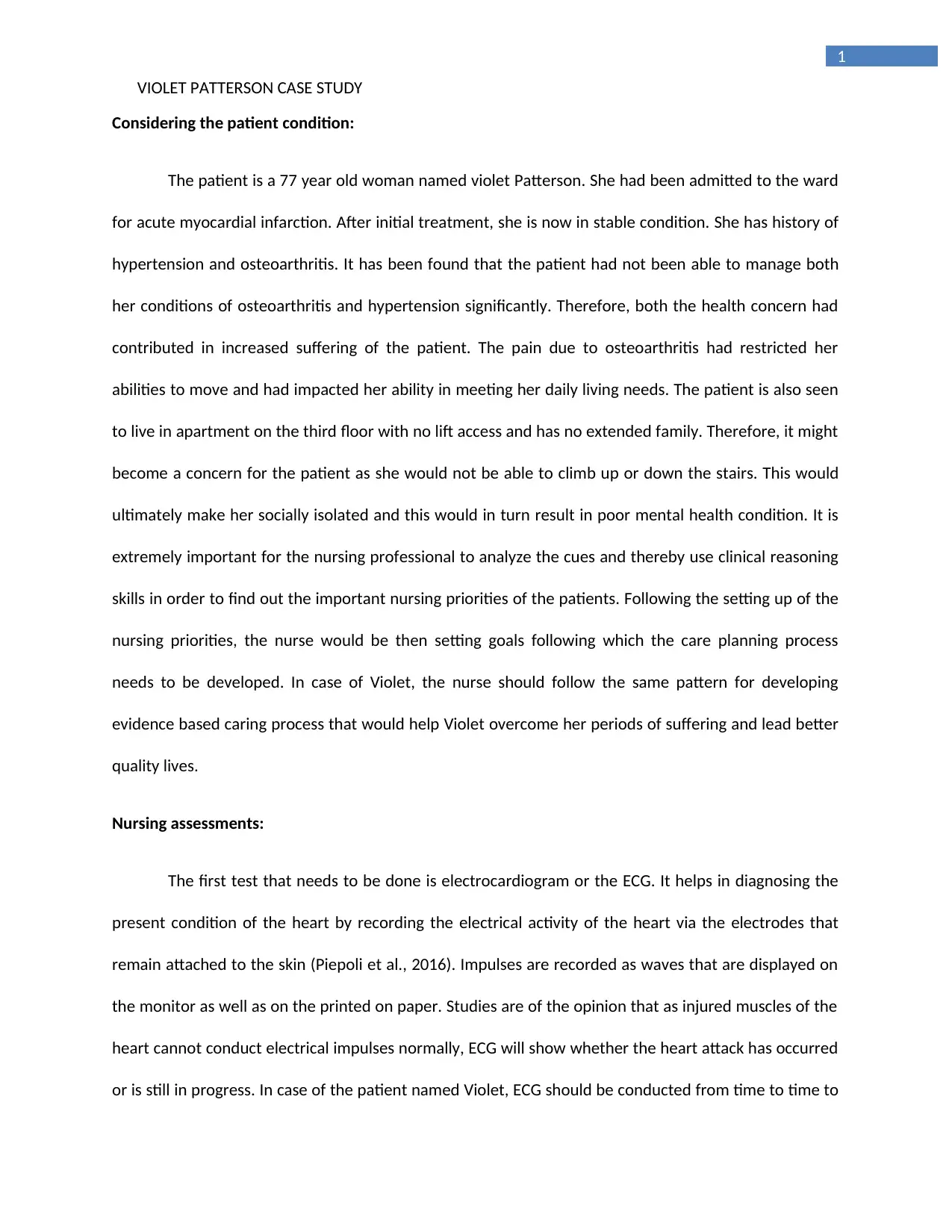
1
VIOLET PATTERSON CASE STUDY
Considering the patient condition:
The patient is a 77 year old woman named violet Patterson. She had been admitted to the ward
for acute myocardial infarction. After initial treatment, she is now in stable condition. She has history of
hypertension and osteoarthritis. It has been found that the patient had not been able to manage both
her conditions of osteoarthritis and hypertension significantly. Therefore, both the health concern had
contributed in increased suffering of the patient. The pain due to osteoarthritis had restricted her
abilities to move and had impacted her ability in meeting her daily living needs. The patient is also seen
to live in apartment on the third floor with no lift access and has no extended family. Therefore, it might
become a concern for the patient as she would not be able to climb up or down the stairs. This would
ultimately make her socially isolated and this would in turn result in poor mental health condition. It is
extremely important for the nursing professional to analyze the cues and thereby use clinical reasoning
skills in order to find out the important nursing priorities of the patients. Following the setting up of the
nursing priorities, the nurse would be then setting goals following which the care planning process
needs to be developed. In case of Violet, the nurse should follow the same pattern for developing
evidence based caring process that would help Violet overcome her periods of suffering and lead better
quality lives.
Nursing assessments:
The first test that needs to be done is electrocardiogram or the ECG. It helps in diagnosing the
present condition of the heart by recording the electrical activity of the heart via the electrodes that
remain attached to the skin (Piepoli et al., 2016). Impulses are recorded as waves that are displayed on
the monitor as well as on the printed on paper. Studies are of the opinion that as injured muscles of the
heart cannot conduct electrical impulses normally, ECG will show whether the heart attack has occurred
or is still in progress. In case of the patient named Violet, ECG should be conducted from time to time to
VIOLET PATTERSON CASE STUDY
Considering the patient condition:
The patient is a 77 year old woman named violet Patterson. She had been admitted to the ward
for acute myocardial infarction. After initial treatment, she is now in stable condition. She has history of
hypertension and osteoarthritis. It has been found that the patient had not been able to manage both
her conditions of osteoarthritis and hypertension significantly. Therefore, both the health concern had
contributed in increased suffering of the patient. The pain due to osteoarthritis had restricted her
abilities to move and had impacted her ability in meeting her daily living needs. The patient is also seen
to live in apartment on the third floor with no lift access and has no extended family. Therefore, it might
become a concern for the patient as she would not be able to climb up or down the stairs. This would
ultimately make her socially isolated and this would in turn result in poor mental health condition. It is
extremely important for the nursing professional to analyze the cues and thereby use clinical reasoning
skills in order to find out the important nursing priorities of the patients. Following the setting up of the
nursing priorities, the nurse would be then setting goals following which the care planning process
needs to be developed. In case of Violet, the nurse should follow the same pattern for developing
evidence based caring process that would help Violet overcome her periods of suffering and lead better
quality lives.
Nursing assessments:
The first test that needs to be done is electrocardiogram or the ECG. It helps in diagnosing the
present condition of the heart by recording the electrical activity of the heart via the electrodes that
remain attached to the skin (Piepoli et al., 2016). Impulses are recorded as waves that are displayed on
the monitor as well as on the printed on paper. Studies are of the opinion that as injured muscles of the
heart cannot conduct electrical impulses normally, ECG will show whether the heart attack has occurred
or is still in progress. In case of the patient named Violet, ECG should be conducted from time to time to
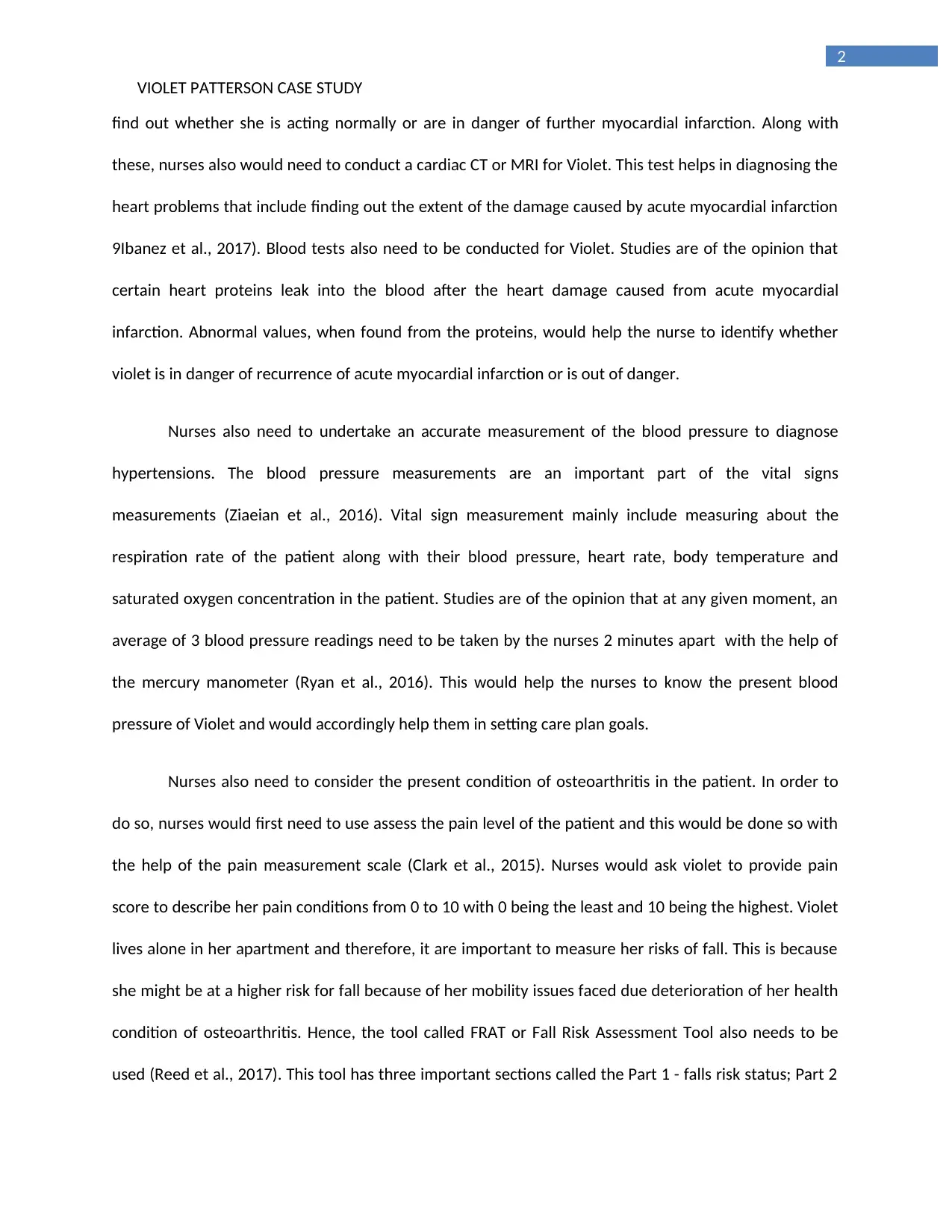
2
VIOLET PATTERSON CASE STUDY
find out whether she is acting normally or are in danger of further myocardial infarction. Along with
these, nurses also would need to conduct a cardiac CT or MRI for Violet. This test helps in diagnosing the
heart problems that include finding out the extent of the damage caused by acute myocardial infarction
9Ibanez et al., 2017). Blood tests also need to be conducted for Violet. Studies are of the opinion that
certain heart proteins leak into the blood after the heart damage caused from acute myocardial
infarction. Abnormal values, when found from the proteins, would help the nurse to identify whether
violet is in danger of recurrence of acute myocardial infarction or is out of danger.
Nurses also need to undertake an accurate measurement of the blood pressure to diagnose
hypertensions. The blood pressure measurements are an important part of the vital signs
measurements (Ziaeian et al., 2016). Vital sign measurement mainly include measuring about the
respiration rate of the patient along with their blood pressure, heart rate, body temperature and
saturated oxygen concentration in the patient. Studies are of the opinion that at any given moment, an
average of 3 blood pressure readings need to be taken by the nurses 2 minutes apart with the help of
the mercury manometer (Ryan et al., 2016). This would help the nurses to know the present blood
pressure of Violet and would accordingly help them in setting care plan goals.
Nurses also need to consider the present condition of osteoarthritis in the patient. In order to
do so, nurses would first need to use assess the pain level of the patient and this would be done so with
the help of the pain measurement scale (Clark et al., 2015). Nurses would ask violet to provide pain
score to describe her pain conditions from 0 to 10 with 0 being the least and 10 being the highest. Violet
lives alone in her apartment and therefore, it are important to measure her risks of fall. This is because
she might be at a higher risk for fall because of her mobility issues faced due deterioration of her health
condition of osteoarthritis. Hence, the tool called FRAT or Fall Risk Assessment Tool also needs to be
used (Reed et al., 2017). This tool has three important sections called the Part 1 - falls risk status; Part 2
VIOLET PATTERSON CASE STUDY
find out whether she is acting normally or are in danger of further myocardial infarction. Along with
these, nurses also would need to conduct a cardiac CT or MRI for Violet. This test helps in diagnosing the
heart problems that include finding out the extent of the damage caused by acute myocardial infarction
9Ibanez et al., 2017). Blood tests also need to be conducted for Violet. Studies are of the opinion that
certain heart proteins leak into the blood after the heart damage caused from acute myocardial
infarction. Abnormal values, when found from the proteins, would help the nurse to identify whether
violet is in danger of recurrence of acute myocardial infarction or is out of danger.
Nurses also need to undertake an accurate measurement of the blood pressure to diagnose
hypertensions. The blood pressure measurements are an important part of the vital signs
measurements (Ziaeian et al., 2016). Vital sign measurement mainly include measuring about the
respiration rate of the patient along with their blood pressure, heart rate, body temperature and
saturated oxygen concentration in the patient. Studies are of the opinion that at any given moment, an
average of 3 blood pressure readings need to be taken by the nurses 2 minutes apart with the help of
the mercury manometer (Ryan et al., 2016). This would help the nurses to know the present blood
pressure of Violet and would accordingly help them in setting care plan goals.
Nurses also need to consider the present condition of osteoarthritis in the patient. In order to
do so, nurses would first need to use assess the pain level of the patient and this would be done so with
the help of the pain measurement scale (Clark et al., 2015). Nurses would ask violet to provide pain
score to describe her pain conditions from 0 to 10 with 0 being the least and 10 being the highest. Violet
lives alone in her apartment and therefore, it are important to measure her risks of fall. This is because
she might be at a higher risk for fall because of her mobility issues faced due deterioration of her health
condition of osteoarthritis. Hence, the tool called FRAT or Fall Risk Assessment Tool also needs to be
used (Reed et al., 2017). This tool has three important sections called the Part 1 - falls risk status; Part 2
⊘ This is a preview!⊘
Do you want full access?
Subscribe today to unlock all pages.

Trusted by 1+ million students worldwide
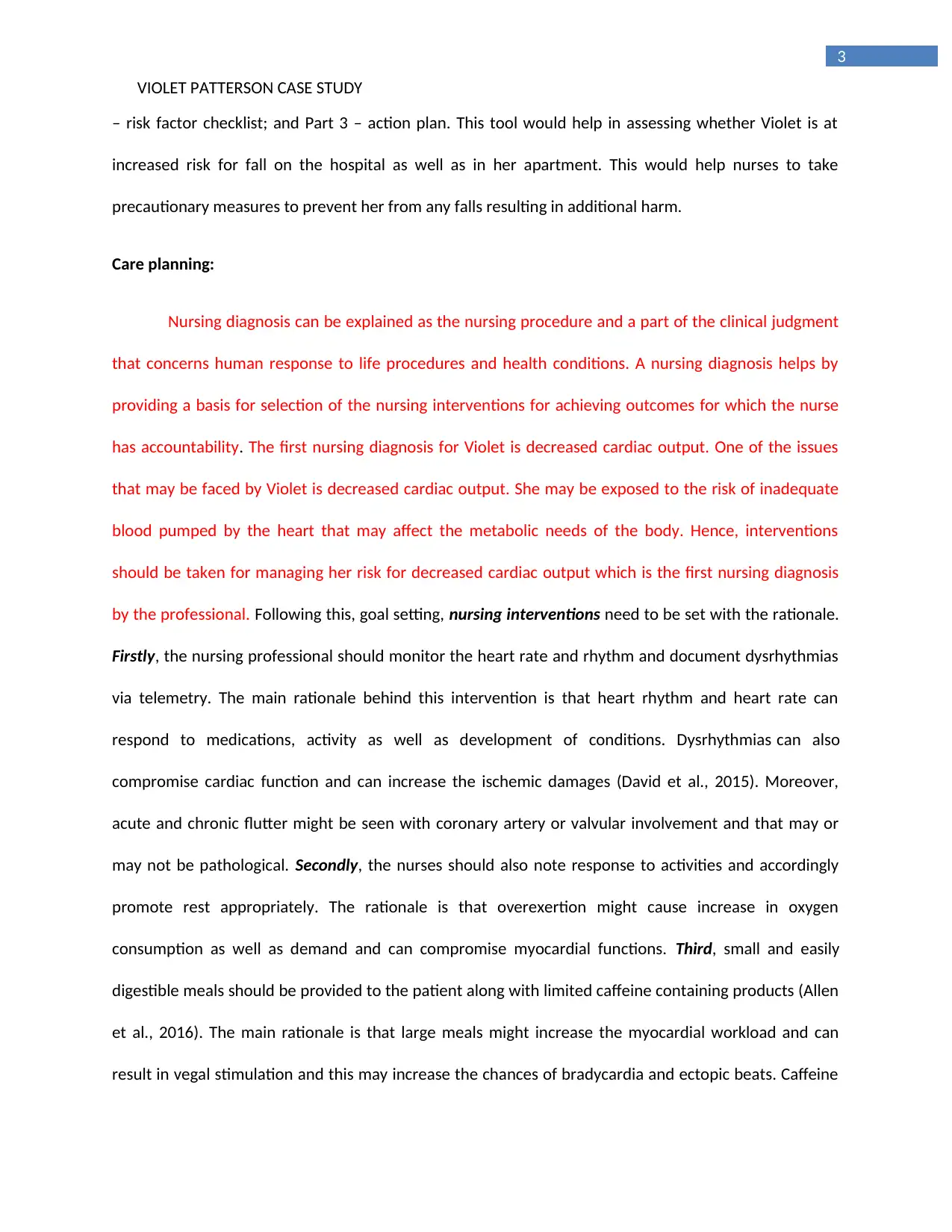
3
VIOLET PATTERSON CASE STUDY
– risk factor checklist; and Part 3 – action plan. This tool would help in assessing whether Violet is at
increased risk for fall on the hospital as well as in her apartment. This would help nurses to take
precautionary measures to prevent her from any falls resulting in additional harm.
Care planning:
Nursing diagnosis can be explained as the nursing procedure and a part of the clinical judgment
that concerns human response to life procedures and health conditions. A nursing diagnosis helps by
providing a basis for selection of the nursing interventions for achieving outcomes for which the nurse
has accountability. The first nursing diagnosis for Violet is decreased cardiac output. One of the issues
that may be faced by Violet is decreased cardiac output. She may be exposed to the risk of inadequate
blood pumped by the heart that may affect the metabolic needs of the body. Hence, interventions
should be taken for managing her risk for decreased cardiac output which is the first nursing diagnosis
by the professional. Following this, goal setting, nursing interventions need to be set with the rationale.
Firstly, the nursing professional should monitor the heart rate and rhythm and document dysrhythmias
via telemetry. The main rationale behind this intervention is that heart rhythm and heart rate can
respond to medications, activity as well as development of conditions. Dysrhythmias can also
compromise cardiac function and can increase the ischemic damages (David et al., 2015). Moreover,
acute and chronic flutter might be seen with coronary artery or valvular involvement and that may or
may not be pathological. Secondly, the nurses should also note response to activities and accordingly
promote rest appropriately. The rationale is that overexertion might cause increase in oxygen
consumption as well as demand and can compromise myocardial functions. Third, small and easily
digestible meals should be provided to the patient along with limited caffeine containing products (Allen
et al., 2016). The main rationale is that large meals might increase the myocardial workload and can
result in vegal stimulation and this may increase the chances of bradycardia and ectopic beats. Caffeine
VIOLET PATTERSON CASE STUDY
– risk factor checklist; and Part 3 – action plan. This tool would help in assessing whether Violet is at
increased risk for fall on the hospital as well as in her apartment. This would help nurses to take
precautionary measures to prevent her from any falls resulting in additional harm.
Care planning:
Nursing diagnosis can be explained as the nursing procedure and a part of the clinical judgment
that concerns human response to life procedures and health conditions. A nursing diagnosis helps by
providing a basis for selection of the nursing interventions for achieving outcomes for which the nurse
has accountability. The first nursing diagnosis for Violet is decreased cardiac output. One of the issues
that may be faced by Violet is decreased cardiac output. She may be exposed to the risk of inadequate
blood pumped by the heart that may affect the metabolic needs of the body. Hence, interventions
should be taken for managing her risk for decreased cardiac output which is the first nursing diagnosis
by the professional. Following this, goal setting, nursing interventions need to be set with the rationale.
Firstly, the nursing professional should monitor the heart rate and rhythm and document dysrhythmias
via telemetry. The main rationale behind this intervention is that heart rhythm and heart rate can
respond to medications, activity as well as development of conditions. Dysrhythmias can also
compromise cardiac function and can increase the ischemic damages (David et al., 2015). Moreover,
acute and chronic flutter might be seen with coronary artery or valvular involvement and that may or
may not be pathological. Secondly, the nurses should also note response to activities and accordingly
promote rest appropriately. The rationale is that overexertion might cause increase in oxygen
consumption as well as demand and can compromise myocardial functions. Third, small and easily
digestible meals should be provided to the patient along with limited caffeine containing products (Allen
et al., 2016). The main rationale is that large meals might increase the myocardial workload and can
result in vegal stimulation and this may increase the chances of bradycardia and ectopic beats. Caffeine
Paraphrase This Document
Need a fresh take? Get an instant paraphrase of this document with our AI Paraphraser
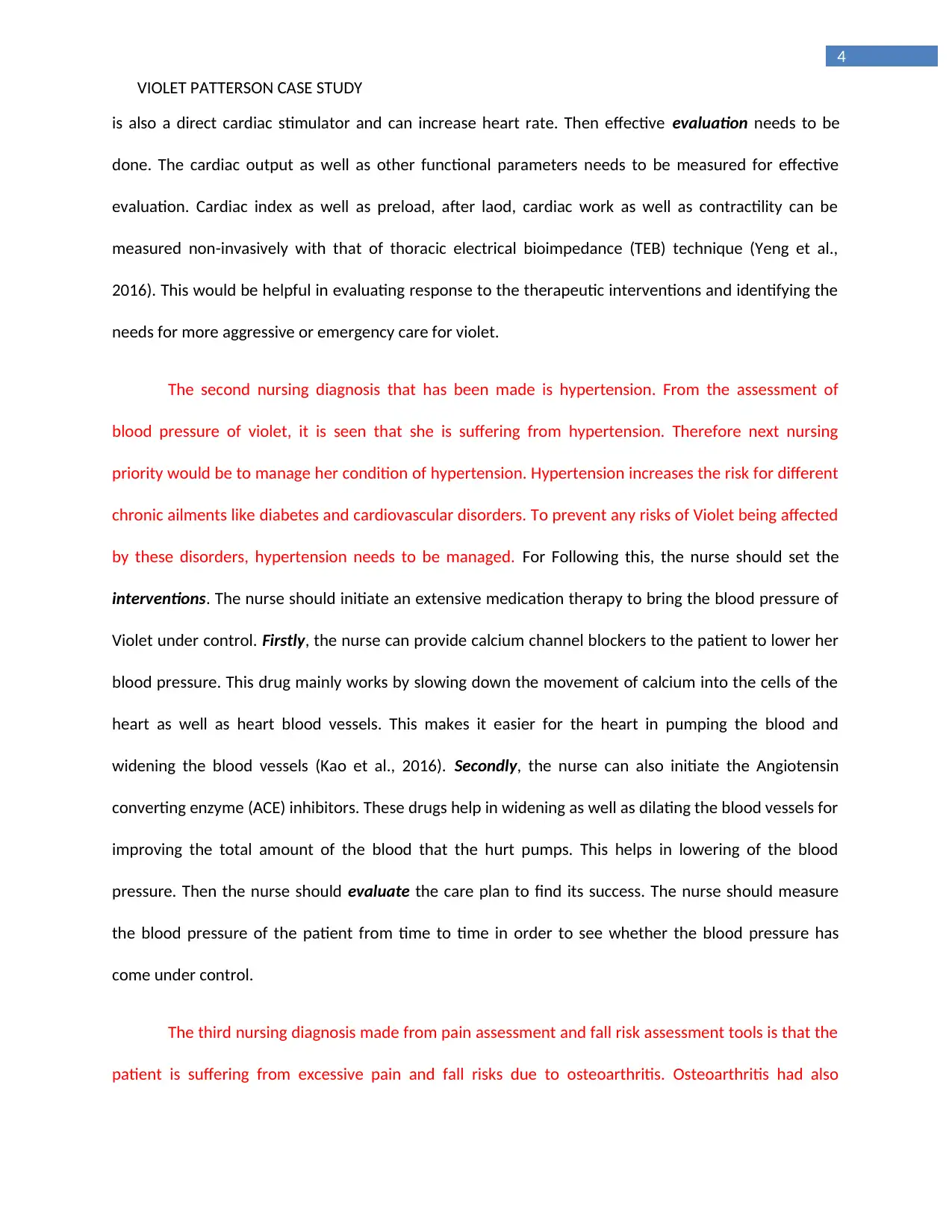
4
VIOLET PATTERSON CASE STUDY
is also a direct cardiac stimulator and can increase heart rate. Then effective evaluation needs to be
done. The cardiac output as well as other functional parameters needs to be measured for effective
evaluation. Cardiac index as well as preload, after laod, cardiac work as well as contractility can be
measured non-invasively with that of thoracic electrical bioimpedance (TEB) technique (Yeng et al.,
2016). This would be helpful in evaluating response to the therapeutic interventions and identifying the
needs for more aggressive or emergency care for violet.
The second nursing diagnosis that has been made is hypertension. From the assessment of
blood pressure of violet, it is seen that she is suffering from hypertension. Therefore next nursing
priority would be to manage her condition of hypertension. Hypertension increases the risk for different
chronic ailments like diabetes and cardiovascular disorders. To prevent any risks of Violet being affected
by these disorders, hypertension needs to be managed. For Following this, the nurse should set the
interventions. The nurse should initiate an extensive medication therapy to bring the blood pressure of
Violet under control. Firstly, the nurse can provide calcium channel blockers to the patient to lower her
blood pressure. This drug mainly works by slowing down the movement of calcium into the cells of the
heart as well as heart blood vessels. This makes it easier for the heart in pumping the blood and
widening the blood vessels (Kao et al., 2016). Secondly, the nurse can also initiate the Angiotensin
converting enzyme (ACE) inhibitors. These drugs help in widening as well as dilating the blood vessels for
improving the total amount of the blood that the hurt pumps. This helps in lowering of the blood
pressure. Then the nurse should evaluate the care plan to find its success. The nurse should measure
the blood pressure of the patient from time to time in order to see whether the blood pressure has
come under control.
The third nursing diagnosis made from pain assessment and fall risk assessment tools is that the
patient is suffering from excessive pain and fall risks due to osteoarthritis. Osteoarthritis had also
VIOLET PATTERSON CASE STUDY
is also a direct cardiac stimulator and can increase heart rate. Then effective evaluation needs to be
done. The cardiac output as well as other functional parameters needs to be measured for effective
evaluation. Cardiac index as well as preload, after laod, cardiac work as well as contractility can be
measured non-invasively with that of thoracic electrical bioimpedance (TEB) technique (Yeng et al.,
2016). This would be helpful in evaluating response to the therapeutic interventions and identifying the
needs for more aggressive or emergency care for violet.
The second nursing diagnosis that has been made is hypertension. From the assessment of
blood pressure of violet, it is seen that she is suffering from hypertension. Therefore next nursing
priority would be to manage her condition of hypertension. Hypertension increases the risk for different
chronic ailments like diabetes and cardiovascular disorders. To prevent any risks of Violet being affected
by these disorders, hypertension needs to be managed. For Following this, the nurse should set the
interventions. The nurse should initiate an extensive medication therapy to bring the blood pressure of
Violet under control. Firstly, the nurse can provide calcium channel blockers to the patient to lower her
blood pressure. This drug mainly works by slowing down the movement of calcium into the cells of the
heart as well as heart blood vessels. This makes it easier for the heart in pumping the blood and
widening the blood vessels (Kao et al., 2016). Secondly, the nurse can also initiate the Angiotensin
converting enzyme (ACE) inhibitors. These drugs help in widening as well as dilating the blood vessels for
improving the total amount of the blood that the hurt pumps. This helps in lowering of the blood
pressure. Then the nurse should evaluate the care plan to find its success. The nurse should measure
the blood pressure of the patient from time to time in order to see whether the blood pressure has
come under control.
The third nursing diagnosis made from pain assessment and fall risk assessment tools is that the
patient is suffering from excessive pain and fall risks due to osteoarthritis. Osteoarthritis had also
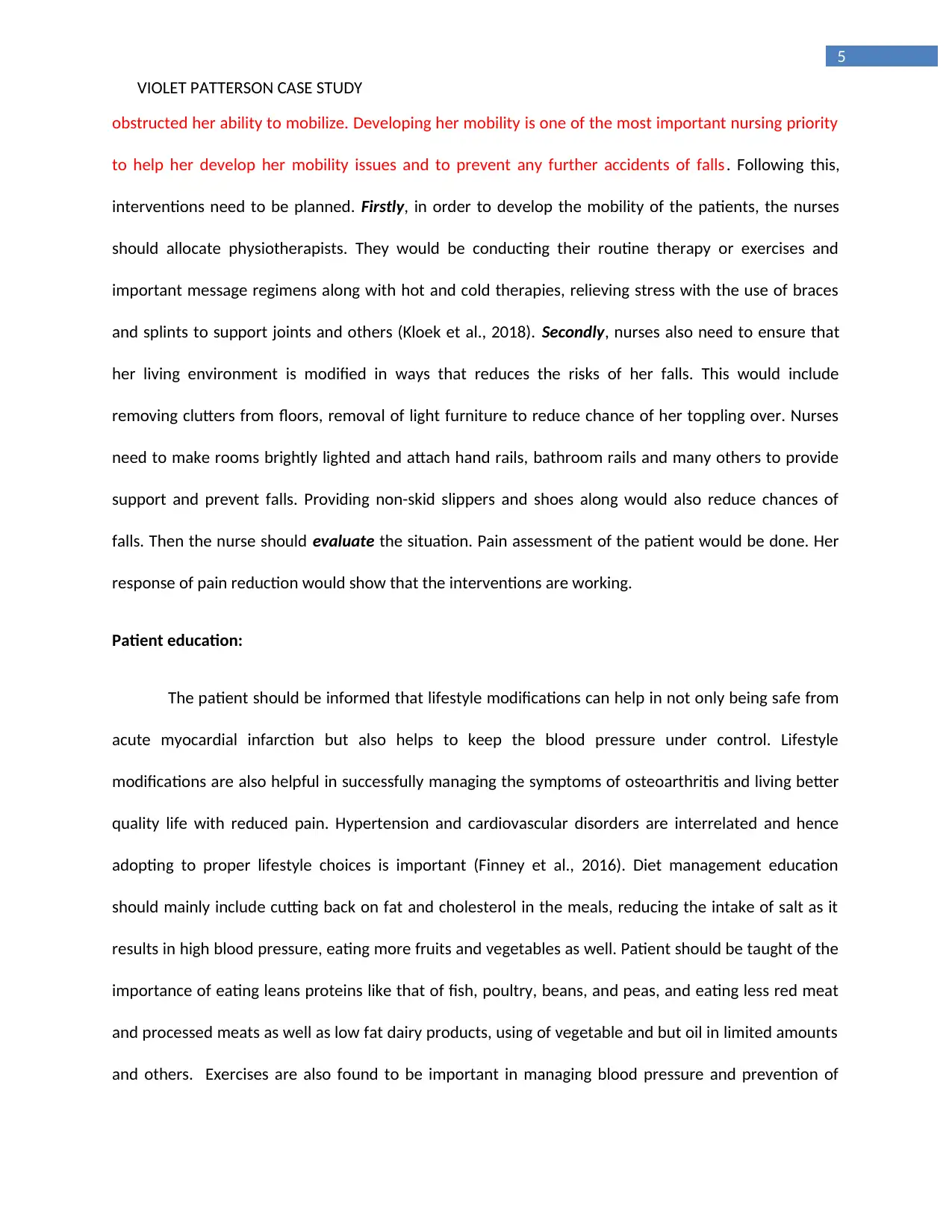
5
VIOLET PATTERSON CASE STUDY
obstructed her ability to mobilize. Developing her mobility is one of the most important nursing priority
to help her develop her mobility issues and to prevent any further accidents of falls . Following this,
interventions need to be planned. Firstly, in order to develop the mobility of the patients, the nurses
should allocate physiotherapists. They would be conducting their routine therapy or exercises and
important message regimens along with hot and cold therapies, relieving stress with the use of braces
and splints to support joints and others (Kloek et al., 2018). Secondly, nurses also need to ensure that
her living environment is modified in ways that reduces the risks of her falls. This would include
removing clutters from floors, removal of light furniture to reduce chance of her toppling over. Nurses
need to make rooms brightly lighted and attach hand rails, bathroom rails and many others to provide
support and prevent falls. Providing non-skid slippers and shoes along would also reduce chances of
falls. Then the nurse should evaluate the situation. Pain assessment of the patient would be done. Her
response of pain reduction would show that the interventions are working.
Patient education:
The patient should be informed that lifestyle modifications can help in not only being safe from
acute myocardial infarction but also helps to keep the blood pressure under control. Lifestyle
modifications are also helpful in successfully managing the symptoms of osteoarthritis and living better
quality life with reduced pain. Hypertension and cardiovascular disorders are interrelated and hence
adopting to proper lifestyle choices is important (Finney et al., 2016). Diet management education
should mainly include cutting back on fat and cholesterol in the meals, reducing the intake of salt as it
results in high blood pressure, eating more fruits and vegetables as well. Patient should be taught of the
importance of eating leans proteins like that of fish, poultry, beans, and peas, and eating less red meat
and processed meats as well as low fat dairy products, using of vegetable and but oil in limited amounts
and others. Exercises are also found to be important in managing blood pressure and prevention of
VIOLET PATTERSON CASE STUDY
obstructed her ability to mobilize. Developing her mobility is one of the most important nursing priority
to help her develop her mobility issues and to prevent any further accidents of falls . Following this,
interventions need to be planned. Firstly, in order to develop the mobility of the patients, the nurses
should allocate physiotherapists. They would be conducting their routine therapy or exercises and
important message regimens along with hot and cold therapies, relieving stress with the use of braces
and splints to support joints and others (Kloek et al., 2018). Secondly, nurses also need to ensure that
her living environment is modified in ways that reduces the risks of her falls. This would include
removing clutters from floors, removal of light furniture to reduce chance of her toppling over. Nurses
need to make rooms brightly lighted and attach hand rails, bathroom rails and many others to provide
support and prevent falls. Providing non-skid slippers and shoes along would also reduce chances of
falls. Then the nurse should evaluate the situation. Pain assessment of the patient would be done. Her
response of pain reduction would show that the interventions are working.
Patient education:
The patient should be informed that lifestyle modifications can help in not only being safe from
acute myocardial infarction but also helps to keep the blood pressure under control. Lifestyle
modifications are also helpful in successfully managing the symptoms of osteoarthritis and living better
quality life with reduced pain. Hypertension and cardiovascular disorders are interrelated and hence
adopting to proper lifestyle choices is important (Finney et al., 2016). Diet management education
should mainly include cutting back on fat and cholesterol in the meals, reducing the intake of salt as it
results in high blood pressure, eating more fruits and vegetables as well. Patient should be taught of the
importance of eating leans proteins like that of fish, poultry, beans, and peas, and eating less red meat
and processed meats as well as low fat dairy products, using of vegetable and but oil in limited amounts
and others. Exercises are also found to be important in managing blood pressure and prevention of
⊘ This is a preview!⊘
Do you want full access?
Subscribe today to unlock all pages.

Trusted by 1+ million students worldwide
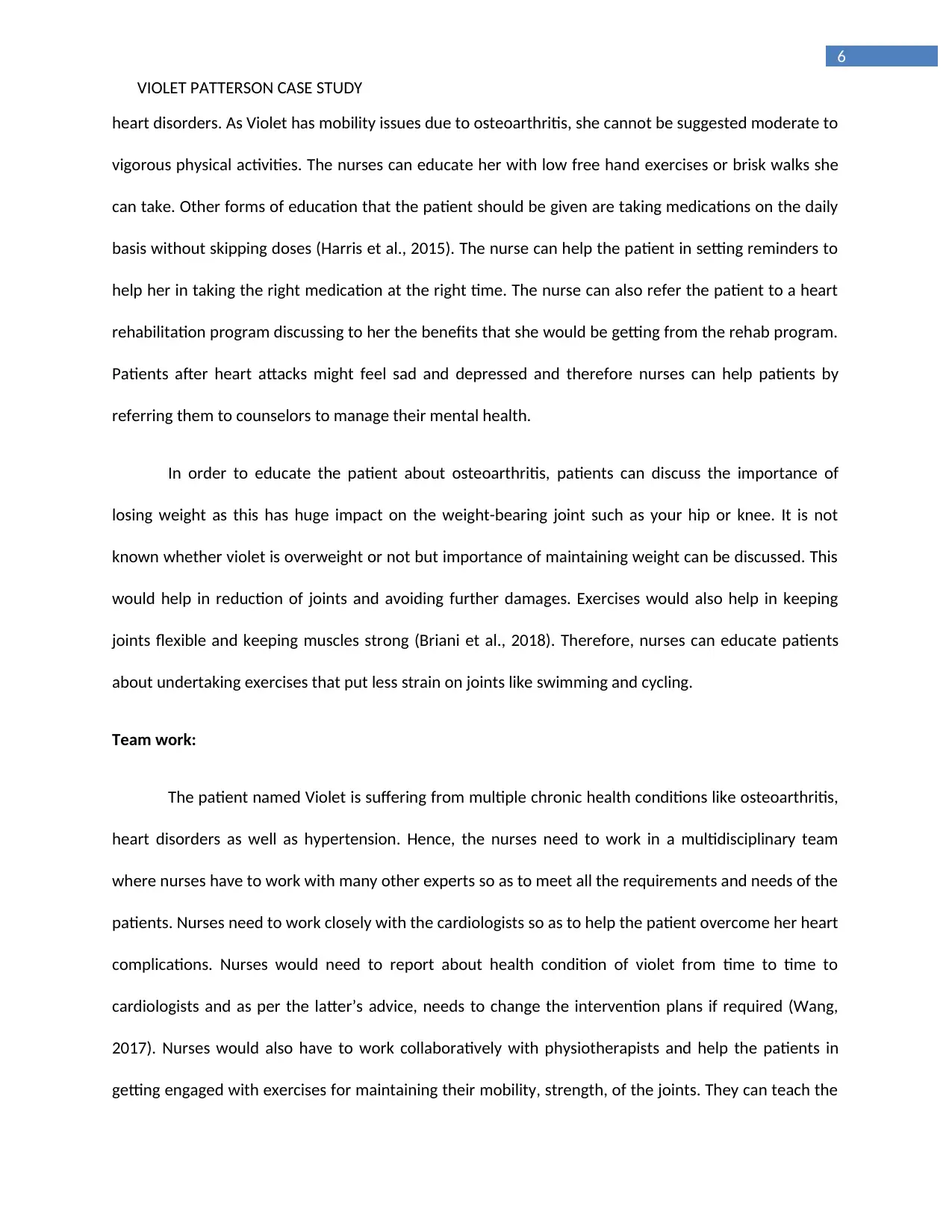
6
VIOLET PATTERSON CASE STUDY
heart disorders. As Violet has mobility issues due to osteoarthritis, she cannot be suggested moderate to
vigorous physical activities. The nurses can educate her with low free hand exercises or brisk walks she
can take. Other forms of education that the patient should be given are taking medications on the daily
basis without skipping doses (Harris et al., 2015). The nurse can help the patient in setting reminders to
help her in taking the right medication at the right time. The nurse can also refer the patient to a heart
rehabilitation program discussing to her the benefits that she would be getting from the rehab program.
Patients after heart attacks might feel sad and depressed and therefore nurses can help patients by
referring them to counselors to manage their mental health.
In order to educate the patient about osteoarthritis, patients can discuss the importance of
losing weight as this has huge impact on the weight-bearing joint such as your hip or knee. It is not
known whether violet is overweight or not but importance of maintaining weight can be discussed. This
would help in reduction of joints and avoiding further damages. Exercises would also help in keeping
joints flexible and keeping muscles strong (Briani et al., 2018). Therefore, nurses can educate patients
about undertaking exercises that put less strain on joints like swimming and cycling.
Team work:
The patient named Violet is suffering from multiple chronic health conditions like osteoarthritis,
heart disorders as well as hypertension. Hence, the nurses need to work in a multidisciplinary team
where nurses have to work with many other experts so as to meet all the requirements and needs of the
patients. Nurses need to work closely with the cardiologists so as to help the patient overcome her heart
complications. Nurses would need to report about health condition of violet from time to time to
cardiologists and as per the latter’s advice, needs to change the intervention plans if required (Wang,
2017). Nurses would also have to work collaboratively with physiotherapists and help the patients in
getting engaged with exercises for maintaining their mobility, strength, of the joints. They can teach the
VIOLET PATTERSON CASE STUDY
heart disorders. As Violet has mobility issues due to osteoarthritis, she cannot be suggested moderate to
vigorous physical activities. The nurses can educate her with low free hand exercises or brisk walks she
can take. Other forms of education that the patient should be given are taking medications on the daily
basis without skipping doses (Harris et al., 2015). The nurse can help the patient in setting reminders to
help her in taking the right medication at the right time. The nurse can also refer the patient to a heart
rehabilitation program discussing to her the benefits that she would be getting from the rehab program.
Patients after heart attacks might feel sad and depressed and therefore nurses can help patients by
referring them to counselors to manage their mental health.
In order to educate the patient about osteoarthritis, patients can discuss the importance of
losing weight as this has huge impact on the weight-bearing joint such as your hip or knee. It is not
known whether violet is overweight or not but importance of maintaining weight can be discussed. This
would help in reduction of joints and avoiding further damages. Exercises would also help in keeping
joints flexible and keeping muscles strong (Briani et al., 2018). Therefore, nurses can educate patients
about undertaking exercises that put less strain on joints like swimming and cycling.
Team work:
The patient named Violet is suffering from multiple chronic health conditions like osteoarthritis,
heart disorders as well as hypertension. Hence, the nurses need to work in a multidisciplinary team
where nurses have to work with many other experts so as to meet all the requirements and needs of the
patients. Nurses need to work closely with the cardiologists so as to help the patient overcome her heart
complications. Nurses would need to report about health condition of violet from time to time to
cardiologists and as per the latter’s advice, needs to change the intervention plans if required (Wang,
2017). Nurses would also have to work collaboratively with physiotherapists and help the patients in
getting engaged with exercises for maintaining their mobility, strength, of the joints. They can teach the
Paraphrase This Document
Need a fresh take? Get an instant paraphrase of this document with our AI Paraphraser
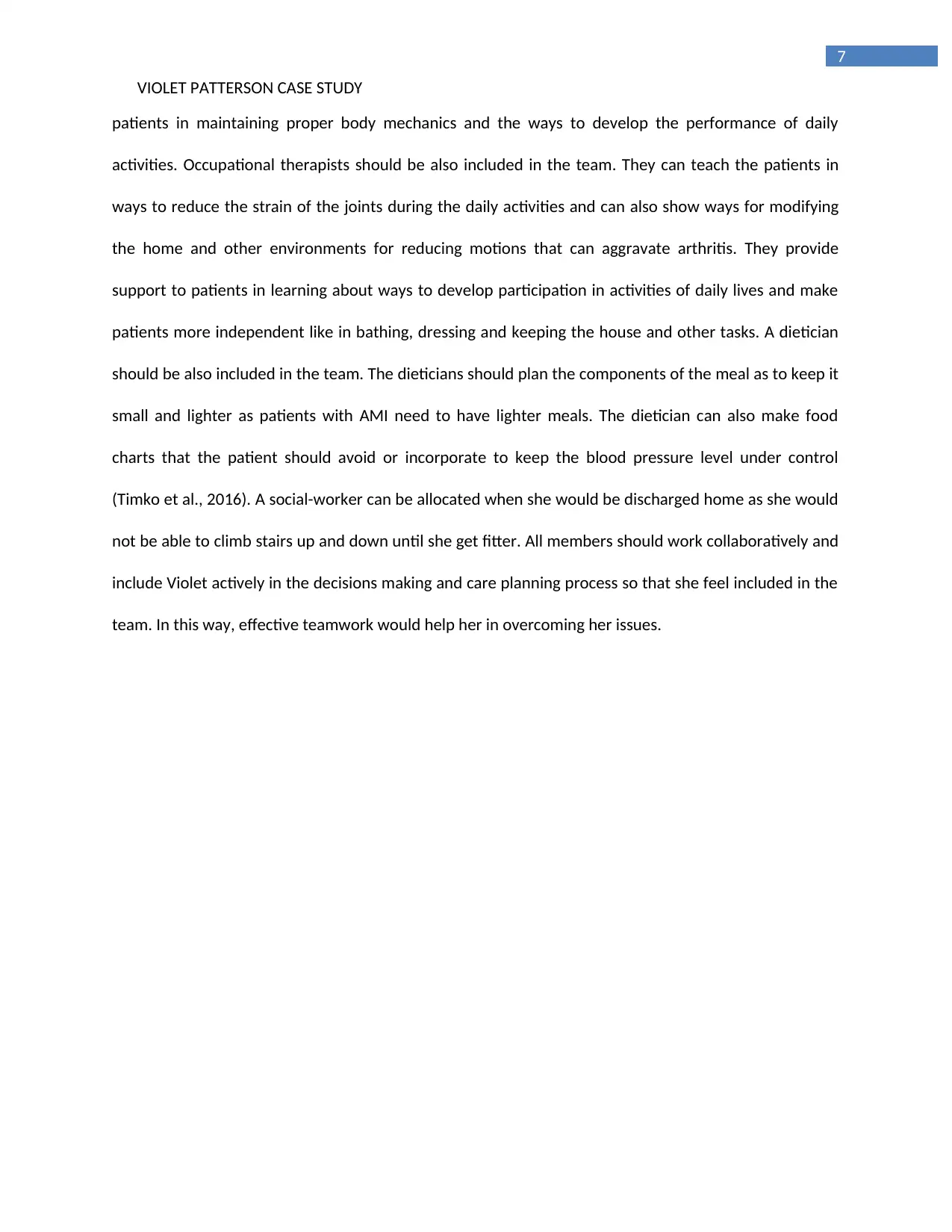
7
VIOLET PATTERSON CASE STUDY
patients in maintaining proper body mechanics and the ways to develop the performance of daily
activities. Occupational therapists should be also included in the team. They can teach the patients in
ways to reduce the strain of the joints during the daily activities and can also show ways for modifying
the home and other environments for reducing motions that can aggravate arthritis. They provide
support to patients in learning about ways to develop participation in activities of daily lives and make
patients more independent like in bathing, dressing and keeping the house and other tasks. A dietician
should be also included in the team. The dieticians should plan the components of the meal as to keep it
small and lighter as patients with AMI need to have lighter meals. The dietician can also make food
charts that the patient should avoid or incorporate to keep the blood pressure level under control
(Timko et al., 2016). A social-worker can be allocated when she would be discharged home as she would
not be able to climb stairs up and down until she get fitter. All members should work collaboratively and
include Violet actively in the decisions making and care planning process so that she feel included in the
team. In this way, effective teamwork would help her in overcoming her issues.
VIOLET PATTERSON CASE STUDY
patients in maintaining proper body mechanics and the ways to develop the performance of daily
activities. Occupational therapists should be also included in the team. They can teach the patients in
ways to reduce the strain of the joints during the daily activities and can also show ways for modifying
the home and other environments for reducing motions that can aggravate arthritis. They provide
support to patients in learning about ways to develop participation in activities of daily lives and make
patients more independent like in bathing, dressing and keeping the house and other tasks. A dietician
should be also included in the team. The dieticians should plan the components of the meal as to keep it
small and lighter as patients with AMI need to have lighter meals. The dietician can also make food
charts that the patient should avoid or incorporate to keep the blood pressure level under control
(Timko et al., 2016). A social-worker can be allocated when she would be discharged home as she would
not be able to climb stairs up and down until she get fitter. All members should work collaboratively and
include Violet actively in the decisions making and care planning process so that she feel included in the
team. In this way, effective teamwork would help her in overcoming her issues.
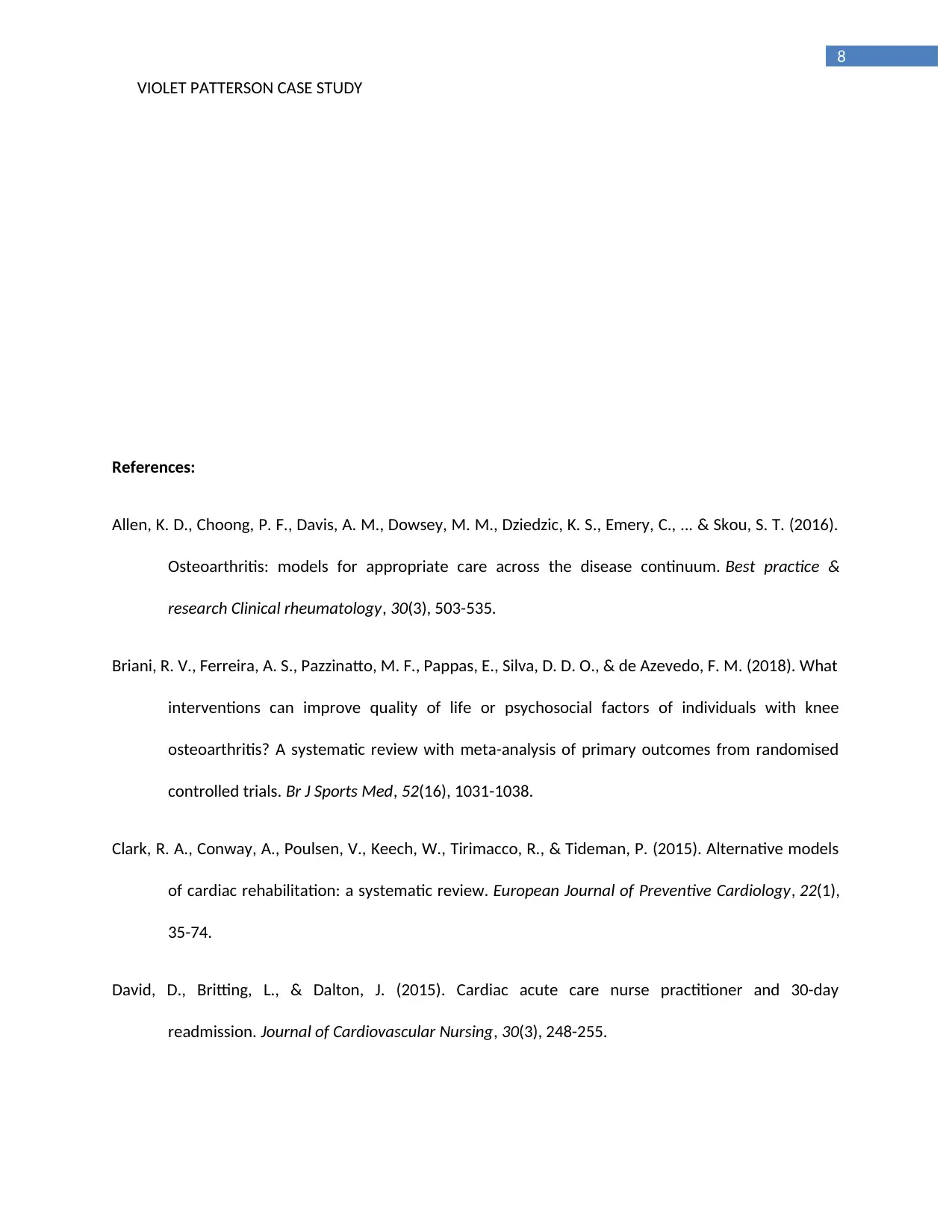
8
VIOLET PATTERSON CASE STUDY
References:
Allen, K. D., Choong, P. F., Davis, A. M., Dowsey, M. M., Dziedzic, K. S., Emery, C., ... & Skou, S. T. (2016).
Osteoarthritis: models for appropriate care across the disease continuum. Best practice &
research Clinical rheumatology, 30(3), 503-535.
Briani, R. V., Ferreira, A. S., Pazzinatto, M. F., Pappas, E., Silva, D. D. O., & de Azevedo, F. M. (2018). What
interventions can improve quality of life or psychosocial factors of individuals with knee
osteoarthritis? A systematic review with meta-analysis of primary outcomes from randomised
controlled trials. Br J Sports Med, 52(16), 1031-1038.
Clark, R. A., Conway, A., Poulsen, V., Keech, W., Tirimacco, R., & Tideman, P. (2015). Alternative models
of cardiac rehabilitation: a systematic review. European Journal of Preventive Cardiology, 22(1),
35-74.
David, D., Britting, L., & Dalton, J. (2015). Cardiac acute care nurse practitioner and 30-day
readmission. Journal of Cardiovascular Nursing, 30(3), 248-255.
VIOLET PATTERSON CASE STUDY
References:
Allen, K. D., Choong, P. F., Davis, A. M., Dowsey, M. M., Dziedzic, K. S., Emery, C., ... & Skou, S. T. (2016).
Osteoarthritis: models for appropriate care across the disease continuum. Best practice &
research Clinical rheumatology, 30(3), 503-535.
Briani, R. V., Ferreira, A. S., Pazzinatto, M. F., Pappas, E., Silva, D. D. O., & de Azevedo, F. M. (2018). What
interventions can improve quality of life or psychosocial factors of individuals with knee
osteoarthritis? A systematic review with meta-analysis of primary outcomes from randomised
controlled trials. Br J Sports Med, 52(16), 1031-1038.
Clark, R. A., Conway, A., Poulsen, V., Keech, W., Tirimacco, R., & Tideman, P. (2015). Alternative models
of cardiac rehabilitation: a systematic review. European Journal of Preventive Cardiology, 22(1),
35-74.
David, D., Britting, L., & Dalton, J. (2015). Cardiac acute care nurse practitioner and 30-day
readmission. Journal of Cardiovascular Nursing, 30(3), 248-255.
⊘ This is a preview!⊘
Do you want full access?
Subscribe today to unlock all pages.

Trusted by 1+ million students worldwide
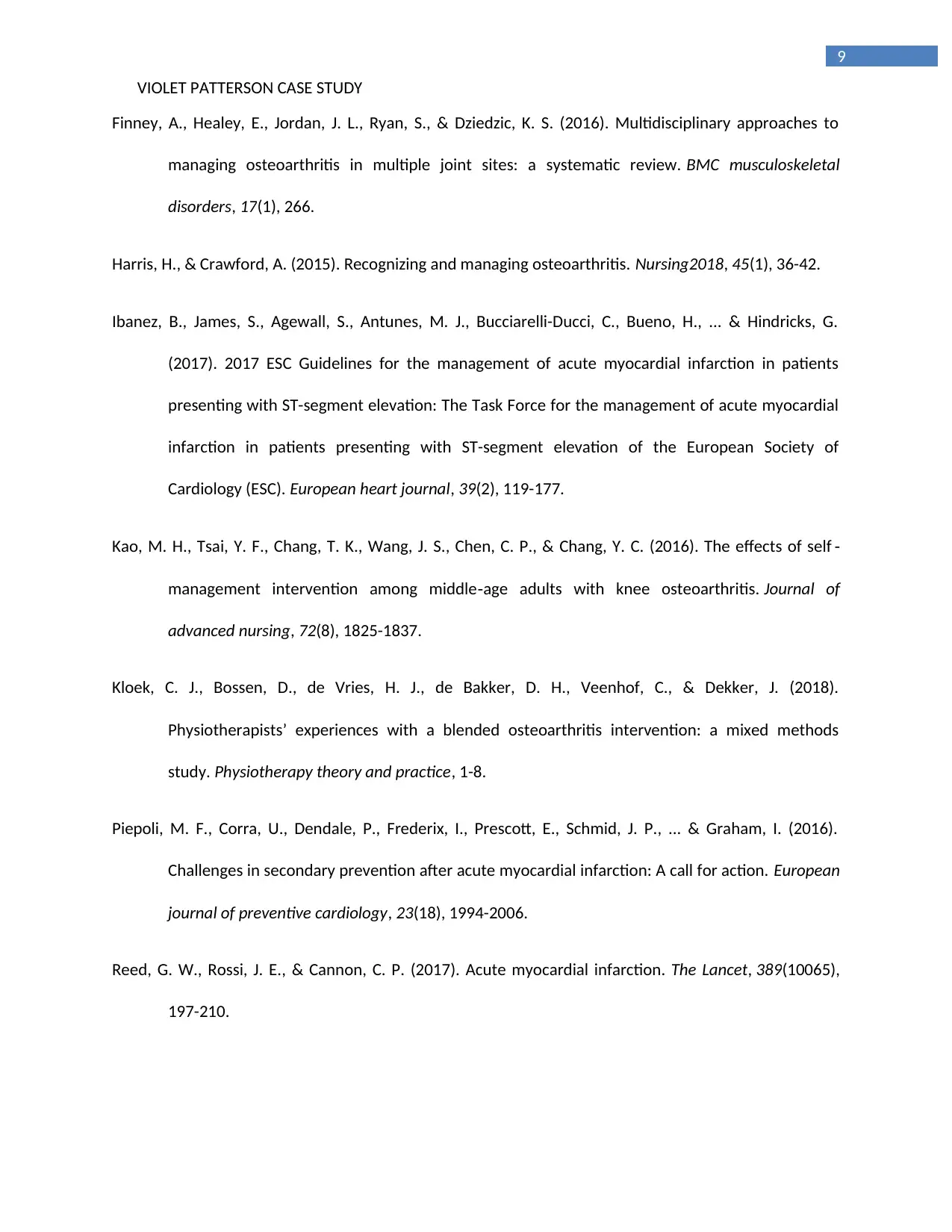
9
VIOLET PATTERSON CASE STUDY
Finney, A., Healey, E., Jordan, J. L., Ryan, S., & Dziedzic, K. S. (2016). Multidisciplinary approaches to
managing osteoarthritis in multiple joint sites: a systematic review. BMC musculoskeletal
disorders, 17(1), 266.
Harris, H., & Crawford, A. (2015). Recognizing and managing osteoarthritis. Nursing2018, 45(1), 36-42.
Ibanez, B., James, S., Agewall, S., Antunes, M. J., Bucciarelli-Ducci, C., Bueno, H., ... & Hindricks, G.
(2017). 2017 ESC Guidelines for the management of acute myocardial infarction in patients
presenting with ST-segment elevation: The Task Force for the management of acute myocardial
infarction in patients presenting with ST-segment elevation of the European Society of
Cardiology (ESC). European heart journal, 39(2), 119-177.
Kao, M. H., Tsai, Y. F., Chang, T. K., Wang, J. S., Chen, C. P., & Chang, Y. C. (2016). The effects of self ‐
management intervention among middle‐age adults with knee osteoarthritis. Journal of
advanced nursing, 72(8), 1825-1837.
Kloek, C. J., Bossen, D., de Vries, H. J., de Bakker, D. H., Veenhof, C., & Dekker, J. (2018).
Physiotherapists’ experiences with a blended osteoarthritis intervention: a mixed methods
study. Physiotherapy theory and practice, 1-8.
Piepoli, M. F., Corra, U., Dendale, P., Frederix, I., Prescott, E., Schmid, J. P., ... & Graham, I. (2016).
Challenges in secondary prevention after acute myocardial infarction: A call for action. European
journal of preventive cardiology, 23(18), 1994-2006.
Reed, G. W., Rossi, J. E., & Cannon, C. P. (2017). Acute myocardial infarction. The Lancet, 389(10065),
197-210.
VIOLET PATTERSON CASE STUDY
Finney, A., Healey, E., Jordan, J. L., Ryan, S., & Dziedzic, K. S. (2016). Multidisciplinary approaches to
managing osteoarthritis in multiple joint sites: a systematic review. BMC musculoskeletal
disorders, 17(1), 266.
Harris, H., & Crawford, A. (2015). Recognizing and managing osteoarthritis. Nursing2018, 45(1), 36-42.
Ibanez, B., James, S., Agewall, S., Antunes, M. J., Bucciarelli-Ducci, C., Bueno, H., ... & Hindricks, G.
(2017). 2017 ESC Guidelines for the management of acute myocardial infarction in patients
presenting with ST-segment elevation: The Task Force for the management of acute myocardial
infarction in patients presenting with ST-segment elevation of the European Society of
Cardiology (ESC). European heart journal, 39(2), 119-177.
Kao, M. H., Tsai, Y. F., Chang, T. K., Wang, J. S., Chen, C. P., & Chang, Y. C. (2016). The effects of self ‐
management intervention among middle‐age adults with knee osteoarthritis. Journal of
advanced nursing, 72(8), 1825-1837.
Kloek, C. J., Bossen, D., de Vries, H. J., de Bakker, D. H., Veenhof, C., & Dekker, J. (2018).
Physiotherapists’ experiences with a blended osteoarthritis intervention: a mixed methods
study. Physiotherapy theory and practice, 1-8.
Piepoli, M. F., Corra, U., Dendale, P., Frederix, I., Prescott, E., Schmid, J. P., ... & Graham, I. (2016).
Challenges in secondary prevention after acute myocardial infarction: A call for action. European
journal of preventive cardiology, 23(18), 1994-2006.
Reed, G. W., Rossi, J. E., & Cannon, C. P. (2017). Acute myocardial infarction. The Lancet, 389(10065),
197-210.
Paraphrase This Document
Need a fresh take? Get an instant paraphrase of this document with our AI Paraphraser
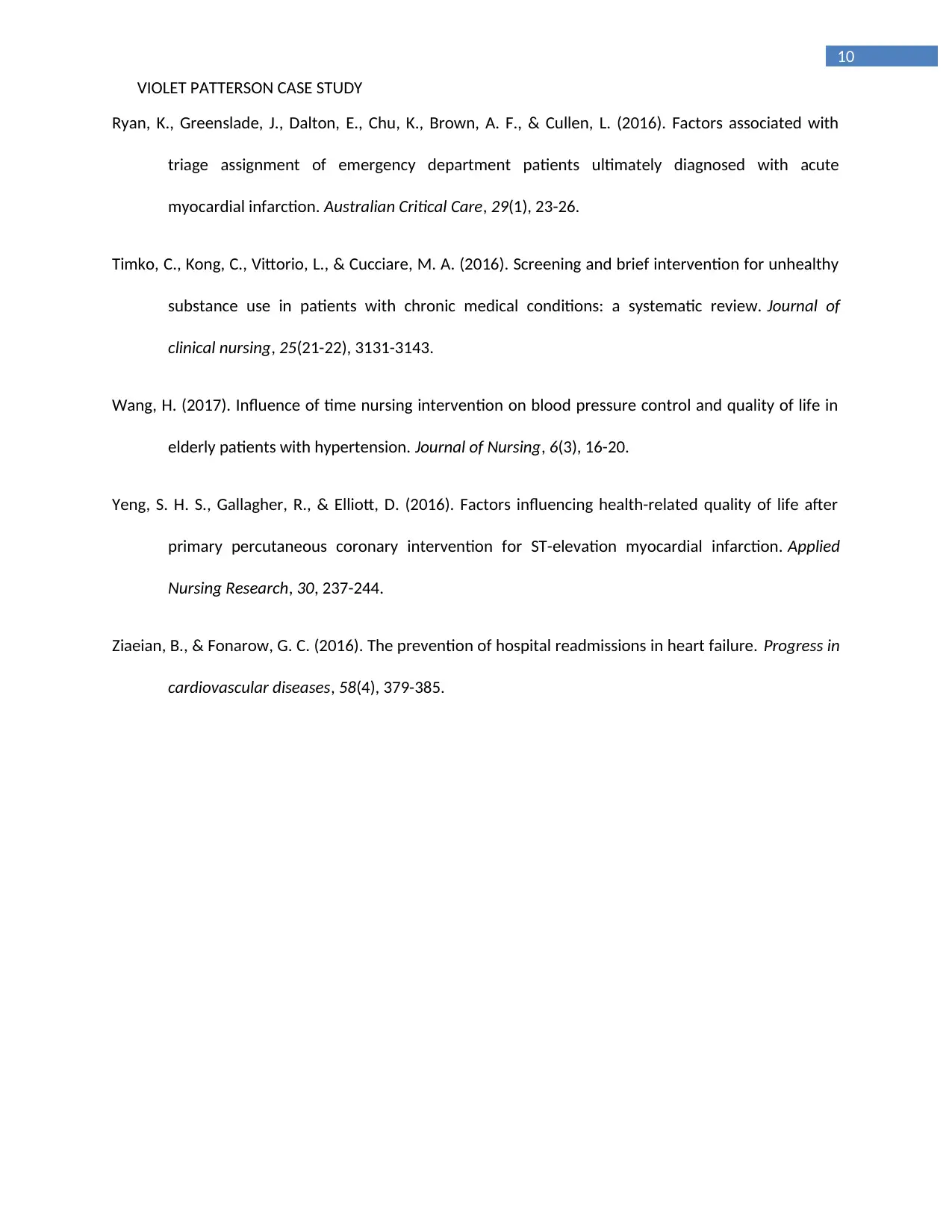
10
VIOLET PATTERSON CASE STUDY
Ryan, K., Greenslade, J., Dalton, E., Chu, K., Brown, A. F., & Cullen, L. (2016). Factors associated with
triage assignment of emergency department patients ultimately diagnosed with acute
myocardial infarction. Australian Critical Care, 29(1), 23-26.
Timko, C., Kong, C., Vittorio, L., & Cucciare, M. A. (2016). Screening and brief intervention for unhealthy
substance use in patients with chronic medical conditions: a systematic review. Journal of
clinical nursing, 25(21-22), 3131-3143.
Wang, H. (2017). Influence of time nursing intervention on blood pressure control and quality of life in
elderly patients with hypertension. Journal of Nursing, 6(3), 16-20.
Yeng, S. H. S., Gallagher, R., & Elliott, D. (2016). Factors influencing health-related quality of life after
primary percutaneous coronary intervention for ST-elevation myocardial infarction. Applied
Nursing Research, 30, 237-244.
Ziaeian, B., & Fonarow, G. C. (2016). The prevention of hospital readmissions in heart failure. Progress in
cardiovascular diseases, 58(4), 379-385.
VIOLET PATTERSON CASE STUDY
Ryan, K., Greenslade, J., Dalton, E., Chu, K., Brown, A. F., & Cullen, L. (2016). Factors associated with
triage assignment of emergency department patients ultimately diagnosed with acute
myocardial infarction. Australian Critical Care, 29(1), 23-26.
Timko, C., Kong, C., Vittorio, L., & Cucciare, M. A. (2016). Screening and brief intervention for unhealthy
substance use in patients with chronic medical conditions: a systematic review. Journal of
clinical nursing, 25(21-22), 3131-3143.
Wang, H. (2017). Influence of time nursing intervention on blood pressure control and quality of life in
elderly patients with hypertension. Journal of Nursing, 6(3), 16-20.
Yeng, S. H. S., Gallagher, R., & Elliott, D. (2016). Factors influencing health-related quality of life after
primary percutaneous coronary intervention for ST-elevation myocardial infarction. Applied
Nursing Research, 30, 237-244.
Ziaeian, B., & Fonarow, G. C. (2016). The prevention of hospital readmissions in heart failure. Progress in
cardiovascular diseases, 58(4), 379-385.
1 out of 11
Related Documents
Your All-in-One AI-Powered Toolkit for Academic Success.
+13062052269
info@desklib.com
Available 24*7 on WhatsApp / Email
![[object Object]](/_next/static/media/star-bottom.7253800d.svg)
Unlock your academic potential
Copyright © 2020–2025 A2Z Services. All Rights Reserved. Developed and managed by ZUCOL.





